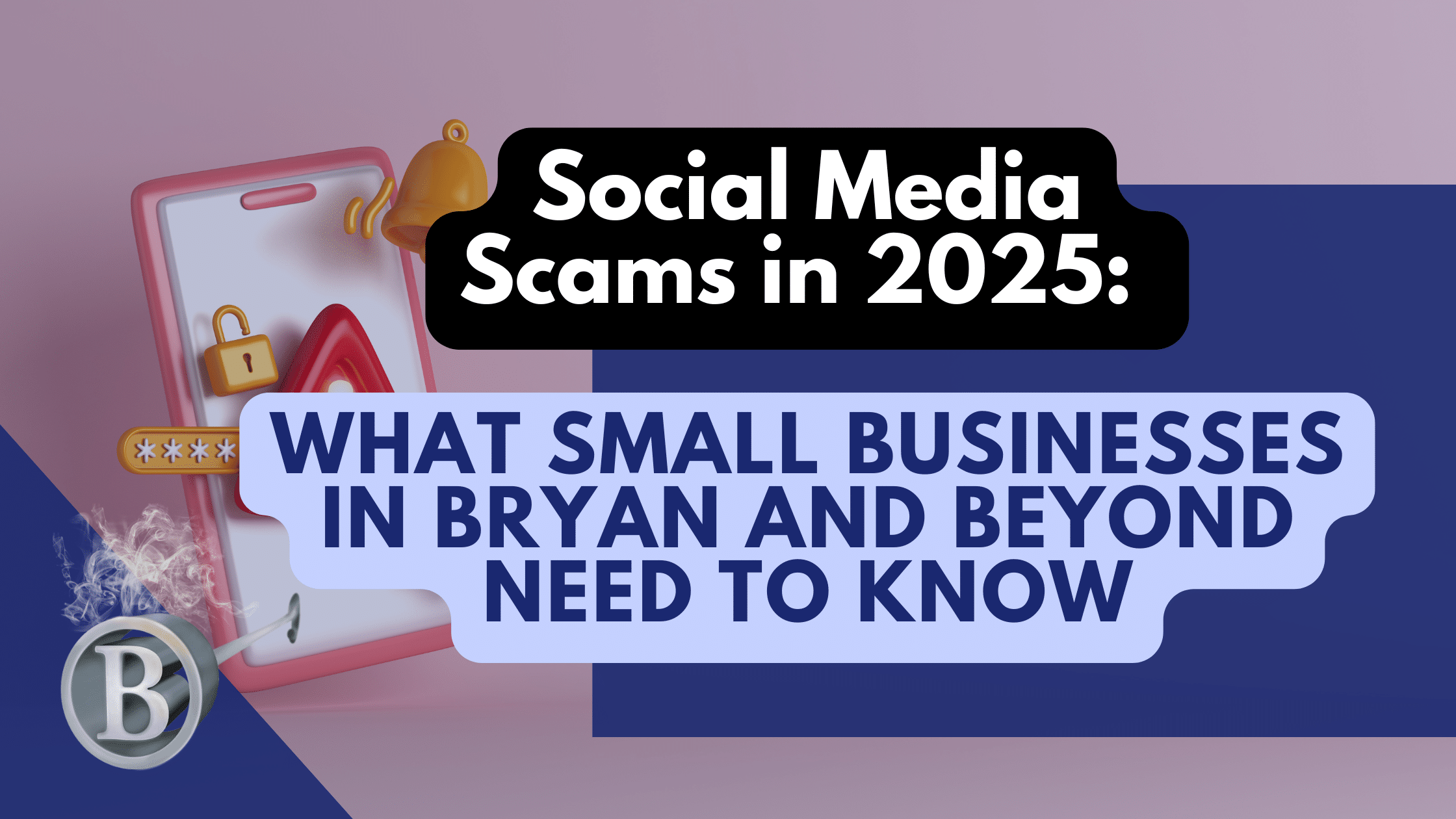In today’s hyper-connected world, business owners and managers aren’t just leading teams and closing deals – they’re also front-line defenders against a new kind of threat: digital scams. From deceptive emails to fake texts and suspicious social messages, cybercriminals have leveled up, targeting businesses with alarming frequency and sophistication.
If you’re a business manager in Bryan, College Station, or anywhere in the Brazos Valley, here’s your guide to staying ahead of scammers.
The Full Spectrum of Modern Scams (and How They Work)
Scams targeting businesses are no longer one-dimensional. Here are the major types to watch for:
- Email Phishing
The most common attack. Hackers impersonate vendors, banks, or even coworkers to get you to click a malicious link or share credentials. These may look legitimate but often contain minor inconsistencies. - Spear Phishing
Targeted attacks that use personal information to appear more convincing. These emails may seem to come from someone inside your company. - Business Email Compromise (BEC)
A fraudster gains access to or mimics an executive’s email to request wire transfers or sensitive data. - Smishing (SMS Phishing)
Text messages urging you to click a link, verify info, or claim a package. These often pretend to be from delivery services, banks, or internal HR departments. - Vishing (Voice Phishing)
Phone calls impersonating vendors, IT support, or bank reps. Some use pre-recorded messages; others deploy live agents with convincing scripts. - Social Media Phishing
Fake messages from LinkedIn, Facebook, or Instagram accounts pretending to be familiar contacts, vendors, or customers. - Vendor Impersonation & Chain Attacks
If one of your partners or vendors gets hacked, scammers can use their email domain to phish your business. - Fake Invoice & Payment Scams
Scammers send what appear to be legitimate invoices, hoping accounts payable departments will process them without a second glance. - Credential Harvesting Sites
Fake login pages designed to steal usernames and passwords. Often linked from phishing emails or texts. - Malware Links & Attachments
Disguised as a file or document, these downloads can infect your systems or steal sensitive information. - Lookalike Domains
Scammers create email addresses or websites that are nearly identical to trusted sources (e.g., @paypall.com instead of @paypal.com). - QR Code Scams
Malicious QR codes that direct you to phishing websites or download malware when scanned. - Deepfake & AI-Generated Content
Emerging threats include voicemails and videos mimicking executives to request sensitive actions.

Red Flags for Business Managers to Watch
- Emails or texts with a sense of urgency or scare tactics
- Slight misspellings in email addresses or domains
- Requests for wire transfers or sensitive data via email
- Unfamiliar links, even from known contacts
- Social media DMs asking you to click links or verify credentials
- Unexpected invoices or payment requests

What to Do If You Think You’ve Been Targeted
- Do Not Click or Respond to the suspicious message.
- Report It internally and flag it with your IT provider.
- Contact the Source using a known communication method – never reply directly.
- Reset Affected Passwords immediately.
- Check Accounts for unauthorized transactions or activity.
- Notify Vendors or Clients if you suspect their info may be compromised.

Smart Practices to Avoid Falling Victim
- Educate Your Team regularly with phishing awareness training.
- Use Multi-Factor Authentication (MFA) on all key accounts.
- Verify Payment Requests through verbal or secondary confirmation.
- Double-Check Links & Email Addresses before clicking.
- Use Strong Passwords and update them routinely.
- Limit Internal Access to sensitive systems and files.
- Use Email Filtering Tools to flag suspicious messages.

Final Thoughts: Leadership Means Vigilance
As a business manager, your role isn’t just to lead – it’s to protect. Scam prevention isn’t just an IT job anymore; it’s a leadership responsibility. By staying informed, training your team, and implementing smart safeguards, you can shield your business from even the most convincing cybercriminal tactics.
When in doubt, pause. Ask questions. Investigate. Because in the battle against phishing, awareness is your greatest weapon.
About Branding Iron Management
Branding Iron Management is a dedicated media management company based in the Bryan-College Station area, boasting over 60 years of experience. Proudly hiring talent from Texas A&M University, our team is composed almost entirely of Aggies, reflecting our commitment to helping local businesses.
We specialize in helping businesses grow through tailored media strategies, digital marketing, graphic design, and social media management. Our comprehensive marketing management services simplify the complexities of advertising, enabling you to effectively engage your target audience and achieve your business goals. At Branding Iron Management, we are in the business of helping businesses grow. Call at (979) 571-9919 or email Branding Iron Management for a free consultation today.
Follow us on social media!










